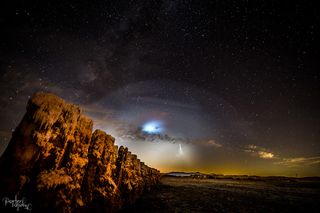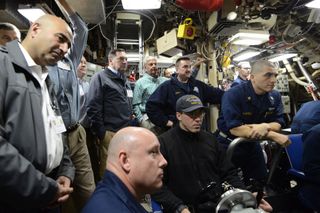Strategic Command Issues Statement on Trident Missile Test that Freaked Out the West Coast

With images like these, it's no wonder California — not to mention the Twittersphere — freaked out Saturday evening when an unannounced test of a submarine-launched Trident missile lit up the evening sky.
Photographer Porter Tinsley and her wife were on the shore of California's desolate Salton Sea taking long exposures and time lapses with three different cameras when they witnessed what they thought at the time was a chemical or nuclear weapon detonating over Los Angeles two and a half hours to the west.
"We thought everyone in L.A. was going to die," said Tinsley, whose blog has even more photos.

Fat chance. The pyrotechnics Tinsley and thousands of other casual skywatchers observed Saturday were due to the first of two Trident 2 D5 missiles with dummy warheads the U.S. Navy test fired between Saturday evening and Monday afternoon. The big, bright flash some mistook Saturday for a detonation, missile intercept or UFO is actually the result of the solid-fueled Trident missile jettisoning one of its three stages.

The test occurred the same day U.S. Secretary of Defense Ash Carter, speaking at the Reagan National Defense Forum in Simi Valley, California, called out Russia for engaging in "challenging activities" at sea, in the air, in space and cyberspace.
In a statement issued Monday night, U.S. Navy Adm. Ceil Haney, head of Strategic Command, described Saturday's test flight — one of 156 such tests since 1989 of the Lockheed Martin-built strategic "demonstrate[s] the readiness of our nation’s nuclear triad and serve to assure our allies and deter our potential adversaries."

Monday's test, conducted in the afternoon, caused far less brouhaha than Saturday's test, which was widely documented on Twitter and social media by unsuspecting skywatchers as far south a Mexico.
Get the Space.com Newsletter
Breaking space news, the latest updates on rocket launches, skywatching events and more!
Strategic Command does not announce Trident tests ahead of time in order not to tip off U.S. adversaries who might want to watch and learn.
Among the select few not caught off guard by the test were five U.S. lawmakers, including Sen. Joe Donnelly (D-Ind.), who were onboard the submarine, the USS Kentucky, to watch Saturday’s launch with Haney and others.

This story was provided by SpaceNews, dedicated to covering all aspects of the space industry.
Join our Space Forums to keep talking space on the latest missions, night sky and more! And if you have a news tip, correction or comment, let us know at: community@space.com.
Mike Gruss is a veteran defense reporter and Editor-in-Chief of Sightline Media Group, which includes Army Times, Air Force Times, Dense News, Military Times and Navy Times. From 2013 to 2016, Mike served as a Senior Staff Writer for SpaceNews covering national security space programs and military space policy in the U.S. Congress. Mike earned a bachelor's degree in English and American Studies from Miami University and has previously wrote for the Journal Gazette in Fort Wayne, Indiana and the Virginian-Pilot in Virginia before joining SpaceNews. Prior to joining Sightline in 2017, he was a senior editor of FedTech magazine covering technology in federal government. You can see Mike's latest project on Twitter.

